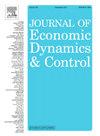Fiscal consolidation in heavily indebted economies
IF 2.3
3区 经济学
Q2 ECONOMICS
引用次数: 0
Abstract
In this paper, I build a dynamic general equilibrium model calibrated to the U.S. economy to study the macroeconomic effects of alternative fiscal consolidation strategies in a context where the private sector is heavily indebted. Fiscal consolidation is defined as a permanent reduction of the public debt-to-GDP ratio through government spending cuts or tax hikes. I show that in the long run, fiscal consolidation entails output benefits that are dampened when private debt is high. This effect occurs independently of the fiscal instrument used to stabilize the debt. In the short run, I find that a fiscal policy that raises labor or capital tax rates induces deleveraging in the private sector, which amplifies temporary output losses due to fiscal consolidation policies. By contrast, a fiscal consolidation achieved by government spending cuts or consumption tax hikes facilitates the repayment of private debt, thereby mitigating the negative output effect associated with a public debt reduction. Finally, regarding social welfare, I find that a fiscal consolidation brings higher welfare gains when government spending or consumption tax rates adjust in an environment of high private debt. However, it increases the social welfare loss when capital or labor tax rates adjust to meet the public debt target.
重负债经济体的财政整顿
在本文中,我建立了一个针对美国经济校准的动态一般均衡模型,以研究私营部门负债累累的背景下替代财政整顿策略的宏观经济效应。财政整顿的定义是,通过政府削减支出或增税,永久性地降低公共债务与gdp之比。我指出,从长期来看,财政整顿带来的产出效益在私人债务高企时受到抑制。这种影响独立于用来稳定债务的财政工具而发生。在短期内,我发现提高劳动或资本税率的财政政策会导致私人部门去杠杆化,从而放大财政整顿政策造成的暂时产出损失。相比之下,通过削减政府支出或提高消费税实现的财政整顿有利于偿还私人债务,从而减轻与削减公共债务相关的负产出效应。最后,关于社会福利,我发现,在私人债务高企的环境下,当政府支出或消费税税率调整时,财政整顿会带来更高的福利收益。然而,当资本或劳动税率调整以满足公共债务目标时,它会增加社会福利损失。
本文章由计算机程序翻译,如有差异,请以英文原文为准。
求助全文
约1分钟内获得全文
求助全文
来源期刊

Journal of Economic Dynamics & Control
ECONOMICS-
CiteScore
3.10
自引率
10.50%
发文量
199
期刊介绍:
The journal provides an outlet for publication of research concerning all theoretical and empirical aspects of economic dynamics and control as well as the development and use of computational methods in economics and finance. Contributions regarding computational methods may include, but are not restricted to, artificial intelligence, databases, decision support systems, genetic algorithms, modelling languages, neural networks, numerical algorithms for optimization, control and equilibria, parallel computing and qualitative reasoning.
 求助内容:
求助内容: 应助结果提醒方式:
应助结果提醒方式:


